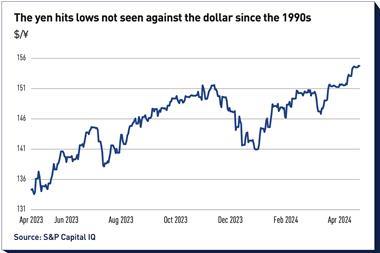The European government bond markets are now larger than the US treasury market, and increasingly seen as an alternative safe haven and source of liquidity by international investors. However, although rapidly evolving to become less demarcated they are, unlike the US, still not a single unified pool of liquidity. An important factor contributing to the development and integration of the Euro-zone government bond market is the existence of generally accepted Euro-zone bond indices.
The leading Euro-zone government bond indices have historically been those produced by individual banks such as JP Morgan and Citigroup. However, in 2003 MTS launched the first real-time Euro-zone bond indices based on prices from around 200 market contributors.
The subsequent introduction of exchange traded funds (ETFs) in 2004 and in January this year, and the EuroMTS Bond Index futures contracts launched by Euronext.liffe, reflect the increasing importance of the EuroMTS framework in a wider European context.
A key element to the acceptability of any set of indices is ensuring accurate and independent pricing. This can be a major issue in the bond markets generally as unlike equities, there is no single exchange price that can be utilised as the current or closing price for a bond.
Given that price sourcing is one of the most critical issues when it comes to indices, a clear distinction can be drawn between those indices produced by investment banks using their own prices as the only source, and indices that obtain prices from a number of independent sources.
The world of bond indices in the past was dominated by market-makers’ own indices with prices sourced only from their own trading desks. The major alternatives to this were the FTSE Global Bond Index Series (formerly Reuters BONDTOP) using market-makers prices on Reuters and the Bloomberg government bond indices based on their generic prices.
Recently, two new sets of indices, iBoxx and EuroMTS, have been introduced and have attracted a great deal of attention as they both address the issue of price sourcing from multiple providers in an effective manner. However, while iBoxx is a step up from the single contributor indices, it still relies on a relatively small number of participants, and prices are indications only and not necessarily tradeable.
In contrast, the EuroMTS indices are based on bond prices quoted on the interdealer MTS electronic trading system, which has around 1,000 market participants from around 200 financial institutions and represents the nearest thing to a market price for any security traded on MTS.
For financial products based on the indices there is value in having as broad a pricing source as possible even if the pricing is usually similar, as it allows small and medium-sized banks to participate in the market rather than allowing price setting to be dominated by the large, primarily US, banks.
The MTS indices are one of the few independent tradeable indices based on best prices from multiple dealers, and this makes them well suited for the creation of derivatives and structured products as Scott Stark, the CEO of MTSNext, the MTS index subsidiary points out.
For investment banks producing OTC derivatives or structured products, it is critical to eliminate tracking errors and ensure valuations are based on prices at which they can actually transact. Stark adds: “Products tied to MTS indices can then be traded by any number of counterparties in contrast to products based on a specific investment bank index, which tend to be shunned by their competitors.”
Lyxor has a range of six ETFs based on the EuroMTS indices covering specific maturity bands with ETFs based on the 1-3 year, 3-5 year, 5-7 year, 7-10 year, 10-15 year and on the all-maturity index. ETF asset growth was over 72% in 2006 with a current total of €3.3bn.
Fund managers with an equity bias can also use such tools to be able to offer competitive approaches to balanced management, although ETFs are a useful tool in the armoury of any fund manager. In addition to being a benchmark, the products that are offered based on the indices (ETFs, derivatives, structured products etc,) provide an easy tool to replicate the indices or to manage cash flows in a portfolio.
The EuroMTS indices arose from a family of total return indices that was developed in 1990 by the French bond association CNO, and was originally exclusively domestic bonds. The introduction of the euro in 1999 led to the original CNO indices being rebranded as the CNO Etrix range and broadened to cover all countries in the Euro-zone. Pricing and production of the indices was then taken over by MTS in January 2003.
The ex-CNO indices remain very popular, particularly in France, with €400bn of funds benchmarked to them. Each sovereign debt market is represented in each of the maturity bands up to 15 years by two securities and by all the benchmark bonds of more than 15 years.
As the bonds are weighted by their respective issuers outstanding bonds in the maturity band, it provides a highly liquid set of indices that are weighted according to the respective market capitalisations. “These indices are easily replicable given the low number of bonds in them, yet maintain a very high correlation to the overall market,” according to Stark.
The introduction of electronic platforms by MTS in each of the major domestic markets alongside the pan-European EuroMTS platform, has encouraged the issuance of a smaller number of larger issues by each country, as issues that are greater than €2bn in size are allowed to be traded on the international EuroMTS platform as well as the domestic MTS platforms.
These bonds are used to produce a separate more comprehensive set of indices - the EMTXg family with both a pan-European and separate German, French and Italian indices. The correlation s these indices and the original ex-CNO indices are, as one might imagine, very high, but the broader basis does make them resemble a typical portfolio holding more closely.
Euronext.liffe has just introduced the EuroMTS Government Bond Index futures contracts on the 7-10 year German, Italian and French indices as well as a pan-European contract. The correlation of the EuroMTS indices with any of the other major indices is very high.
Besides a specific set of indices for Italy, the MTS suite of government bond indices also includes an inflation-linked index and country sub-indices composed of Euro-zone sovereign inflation-linked bonds, giving the only real time inflation index in the Euro-zone according to Stark.
In addition to the six ETFs described above, Lyxor has also issued an ETF based on the EuroMTS inflation lined index. There is also a separate set of government bond indices for the new members of the EU known as the EMTXn index.
The other major set of indices based on the MTS platform are the EMTXc covered bond indices which, as well as including aggregate sub-indices indices covering separate maturity bands, also currently has separate country indices for the major covered bond markets of Germany, France, the UK and Ireland.












No comments yet